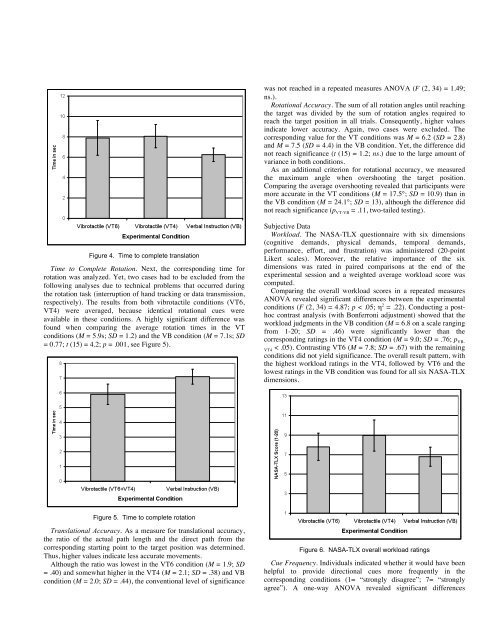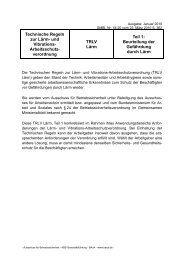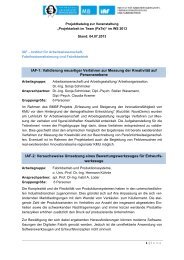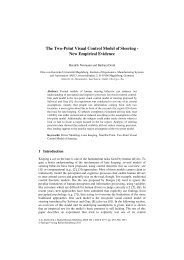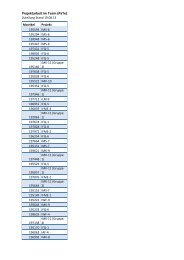Weber Schaetzle Hulin Preusche und Deml _ ... - OvGU::FMB::IAF
Weber Schaetzle Hulin Preusche und Deml _ ... - OvGU::FMB::IAF
Weber Schaetzle Hulin Preusche und Deml _ ... - OvGU::FMB::IAF
You also want an ePaper? Increase the reach of your titles
YUMPU automatically turns print PDFs into web optimized ePapers that Google loves.
Figure 4. Time to complete translation<br />
Time to Complete Rotation. Next, the corresponding time for<br />
rotation was analyzed. Yet, two cases had to be excluded from the<br />
following analyses due to technical problems that occurred during<br />
the rotation task (interruption of hand tracking or data transmission,<br />
respectively). The results from both vibrotactile conditions (VT6,<br />
VT4) were averaged, because identical rotational cues were<br />
available in these conditions. A highly significant difference was<br />
fo<strong>und</strong> when comparing the average rotation times in the VT<br />
conditions (M = 5.9s; SD = 1.2) and the VB condition (M = 7.1s; SD<br />
= 0.77; t (15) = 4.2; p = .001, see Figure 5).<br />
Figure 5. Time to complete rotation<br />
Translational Accuracy. As a measure for translational accuracy,<br />
the ratio of the actual path length and the direct path from the<br />
corresponding starting point to the target position was determined.<br />
Thus, higher values indicate less accurate movements.<br />
Although the ratio was lowest in the VT6 condition (M = 1.9; SD<br />
= .40) and somewhat higher in the VT4 (M = 2.1; SD = .38) and VB<br />
condition (M = 2.0; SD = .44), the conventional level of significance<br />
was not reached in a repeated measures ANOVA (F (2, 34) = 1.49;<br />
ns.).<br />
Rotational Accuracy. The sum of all rotation angles until reaching<br />
the target was divided by the sum of rotation angles required to<br />
reach the target position in all trials. Consequently, higher values<br />
indicate lower accuracy. Again, two cases were excluded. The<br />
corresponding value for the VT conditions was M = 6.2 (SD = 2.8)<br />
and M = 7.5 (SD = 4.4) in the VB condition. Yet, the difference did<br />
not reach significance (t (15) = 1.2; ns.) due to the large amount of<br />
variance in both conditions.<br />
As an additional criterion for rotational accuracy, we measured<br />
the maximum angle when overshooting the target position.<br />
Comparing the average overshooting revealed that participants were<br />
more accurate in the VT conditions (M = 17.5°; SD = 10.9) than in<br />
the VB condition (M = 24.1°; SD = 13), although the difference did<br />
not reach significance (p VT-VB = .11, two-tailed testing).<br />
Subjective Data<br />
Workload. The NASA-TLX questionnaire with six dimensions<br />
(cognitive demands, physical demands, temporal demands,<br />
performance, effort, and frustration) was administered (20-point<br />
Likert scales). Moreover, the relative importance of the six<br />
dimensions was rated in paired comparisons at the end of the<br />
experimental session and a weighted average workload score was<br />
computed.<br />
Comparing the overall workload scores in a repeated measures<br />
ANOVA revealed significant differences between the experimental<br />
conditions (F (2, 34) = 4.87; p < .05; η 2 = .22). Conducting a posthoc<br />
contrast analysis (with Bonferroni adjustment) showed that the<br />
workload judgments in the VB condition (M = 6.8 on a scale ranging<br />
from 1-20; SD = .46) were significantly lower than the<br />
corresponding ratings in the VT4 condition (M = 9.0; SD = .76; p VB-<br />
VT4 < .05). Contrasting VT6 (M = 7.8; SD = .67) with the remaining<br />
conditions did not yield significance. The overall result pattern, with<br />
the highest workload ratings in the VT4, followed by VT6 and the<br />
lowest ratings in the VB condition was fo<strong>und</strong> for all six NASA-TLX<br />
dimensions.<br />
Figure 6. NASA-TLX overall workload ratings<br />
Cue Frequency. Individuals indicated whether it would have been<br />
helpful to provide directional cues more frequently in the<br />
corresponding conditions (1= “strongly disagree”; 7= “strongly<br />
agree”). A one-way ANOVA revealed significant differences


